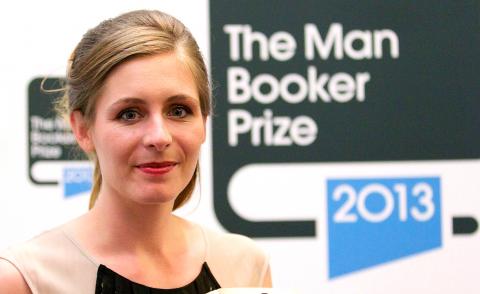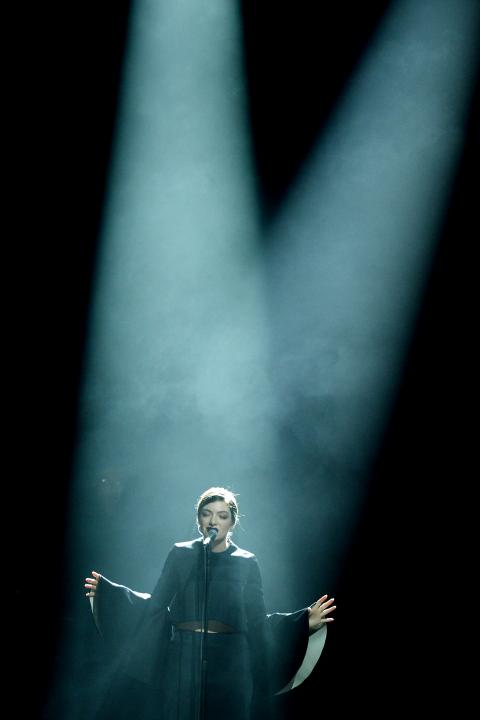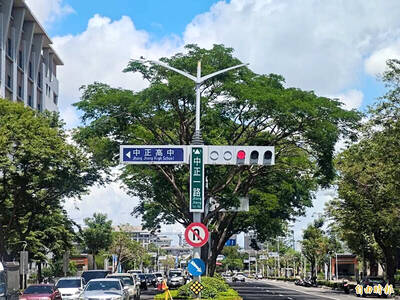For more than a decade, New Zealand’s cultural profile in the world has mostly involved dressing up as Middle-earth. There is no shame in that — Peter Jackson’s cinematic enactments of Tolkien’s works have generated acclaim, pride, jobs and millions of tourism dollars. But New Zealanders are nevertheless to be forgiven for enjoying a breath of fresh air in the achievements of two young and preternaturally eloquent artists.
Royals, the single by Auckland 17-year-old Lorde, again topped the US Billboard Hot 100 last week. When it first hit number one, nine weeks ago, Lorde, or Ella Yelich-O’Connor, was 16 and already the pop world’s most intriguing and important new star.
About halfway through that run, her compatriot Eleanor Catton was called to the stage at the Guildhall to accept the Man Booker prize for The Luminaries, a 19th-century gold rush murder mystery. She became — as is now obligatory to note — the youngest winner in the award’s history (28) with its longest book (832 pages).

Photo: AFP
To the New Zealand ambassadorial corps of Hobbits must now be added a host of creative women. Alongside Catton and Lorde stand the celebrated film-maker Jane Campion, whose most recent work, the darkly entangling TV series Top of the Lake, has won critical acclaim in the US and Britain; the golfing prodigy Lydia Ko, a 16-year-old who has just turned professional; and Helen Clark, the former prime minister who is now the third most senior figure at the United Nations, where she heads the development program (UNDP).
It’s too soon, probably, to call it a wave. But undoubtedly the islands are enjoying a purple patch. Boastfulness may often be frowned on in New Zealand — apart from humility: you can brag about that — but on the cultural and sporting stages of 2013 there has been plenty to cheer. The most scrutinized New Zealanders of all, the All Blacks, a week ago achieved something unprecedented for a national side in the professional era of rugby union, winning every game in a calendar year. The special celebratory cover around the New Zealand Herald, the country’s biggest newspaper, christened them “The Unbeatables” — elevating the side into the pantheon alongside The Originals of 1905-06 and The Invincibles of 1924-25.
Catton’s Man Booker victory has also been front-page news. A Herald editorial reckoned that their endeavors permitted New Zealanders to “celebrate a reputation for artistic work that combines ambition with startling originality. For now, talk about New Zealand need no longer focus on the All Blacks or the America’s Cup.”

Photo: EPA
New Zealanders’ predilection for sport — and the last-minute America’s Cup sailing defeat was possibly the biggest story here of the year — has long been a yardstick for cultural achievement. The prime minister, John Key, accidentally summed it up, once writing that “while our literary heroes may never challenge the glory and respect given to our All Blacks, we still need role models to inspire us.”
There was no such clumsiness from Key, however, when parliament paused to hear tributes to Catton in the week of her London win. “It is exciting and inspiring that our ambassadors in the arts and culture who right now hold the attention of the world are fiercely intelligent and ferociously talented young women,” he said. “Their successes are testament to their skills and hard work, and an inspiration for all New Zealanders.”
New Zealand’s bright young things are fans of each other, too. When both were in New York in early November, expatriate culture writer Gemma Gracewood orchestrated a get-together, having contacted Lorde’s mother, the poet Sonja Yelich, through mutual friends. A pair of photographs, one of Lorde and Catton sitting upright in bed, another with them grinning at their image on a mobile phone, featured on front pages in the next morning’s New Zealand newspapers.
“These cultural superstars were both in New York City at the same time, and wasn’t it just something that had to happen?” Gracewood would later write in a blog post.
The successes of New Zealanders are felt differently by the diaspora, says Gracewood over the phone from New York. “We’re a tiny country and it’s not until you live overseas that you realize just how very far away it is. Not just physically, but also in the minds of people. And so when New Zealanders do well on the world stage, suddenly New Zealand itself feels a whole lot louder and closer than it usually does.”
While Catton and Lorde are special talents, neither is an aberration: New Zealand’s music and books are both in rude health. Nevertheless, the young women’s accolades are a fillip to others. “The win is fabulous for Ellie but hopefully it will also feed interest in some of the other stellar writing that is coming out of New Zealand,” says the New Zealand Book Council’s Catriona Ferguson.
The “phenomenal successes” of Lorde mean that “New Zealand is suddenly being seen as a source of repertoire, a place where great songs come from,” says Cath Andersen of the New Zealand Music Commission. “It’s like the musical version of the spotlight that Sir Peter Jackson swung on to our film industry and the scenic locations.”
TURNING TIDE
Even before Jackson, New Zealand had experience of that spotlight. It was 20 years ago that Jane Campion’s The Piano won at Cannes. Keri Hulme took the Booker Prize with The Bone People in 1985 (the year Catton was born). New Zealand pop music has long held its own globally.
So does this mark some sort of New Zealand cultural coming of age, or is the Lorde-Catton axis a coincidence?
Something has changed, says John Campbell, a vocal enthusiast for New Zealand culture and sport, and presenter of the country’s pre-eminent current affairs show, Campbell Live. He remembers attending, as a fresher, a class at Victoria University of Wellington. It was “one of those awful tutorials where you all introduce yourselves to each other [and] one of the questions we were asked to consider was: What is New Zealand culture?” he says.
“It was desultory. Remember, we were only 18 and all pretty unworldly, but other than rugby, farming and a vague sense of something to do with fencing wire, none of us could come up with anything. That was 30 years ago.
“Ask my children the same question, and you couldn’t shut them up. The difference is that no one told Lorde and Ellie we didn’t have a culture. They knew we did. And because of that, they were able to be themselves. Where once we could dream of being All Blacks, and great farmers, and perhaps even inventing an outboard motor, now our youngsters live in a chapel of possibility so broad that anything’s on the cards. And then it’s up to talent.”
The sun does not shine everywhere. The New Zealand screen industry is teetering on the brink of crisis, victim of a strong currency and a tax-break bidding-war to attract big US productions. Incomes are dwarfed by Australia’s. A housing bubble looms. Thousands in Christchurch continue to live in miserable conditions, locked in insurance disputes almost three years after it was struck by a major earthquake.
And the biggest story of the last month has been achingly inward-looking, focused on a group of alleged young male sexual predators in West Auckland who have avoided police charges despite complaints of rape from girls as young as 13. The impact has been palpable: as if the country had been struck in the solar plexus, winded.
It was at about that time that Gracewood posted the images of Catton and Lorde together in New York. It was a kind of tonic. “Sonja and I sat in a cafe and thought: this is going to make so many people happy right now, this is a perfect distraction,” she says. “This is going to bring to the front pages what should be on the front pages.”
On her blog, she put it like this: “As the Ella/Ellie photo was shared and shared again, I watched happiness and delight spread across Twitter and beyond. We forgot for a few minutes about what else was leading the news. We celebrated Ella and Eleanor’s successes. We delighted in the fact that they found each other in a massive foreign city, in the midst of their career whirlwind, and shared the moment with us ... The timing was good.”

June 9 to June 15 A photo of two men riding trendy high-wheel Penny-Farthing bicycles past a Qing Dynasty gate aptly captures the essence of Taipei in 1897 — a newly colonized city on the cusp of great change. The Japanese began making significant modifications to the cityscape in 1899, tearing down Qing-era structures, widening boulevards and installing Western-style infrastructure and buildings. The photographer, Minosuke Imamura, only spent a year in Taiwan as a cartographer for the governor-general’s office, but he left behind a treasure trove of 130 images showing life at the onset of Japanese rule, spanning July 1897 to

One of the most important gripes that Taiwanese have about the Democratic Progressive Party (DPP) is that it has failed to deliver concretely on higher wages, housing prices and other bread-and-butter issues. The parallel complaint is that the DPP cares only about glamor issues, such as removing markers of Chinese Nationalist Party (KMT) colonialism by renaming them, or what the KMT codes as “de-Sinification.” Once again, as a critical election looms, the DPP is presenting evidence for that charge. The KMT was quick to jump on the recent proposal of the Ministry of the Interior (MOI) to rename roads that symbolize

On the evening of June 1, Control Yuan Secretary-General Lee Chun-yi (李俊俋) apologized and resigned in disgrace. His crime was instructing his driver to use a Control Yuan vehicle to transport his dog to a pet grooming salon. The Control Yuan is the government branch that investigates, audits and impeaches government officials for, among other things, misuse of government funds, so his misuse of a government vehicle was highly inappropriate. If this story were told to anyone living in the golden era of swaggering gangsters, flashy nouveau riche businessmen, and corrupt “black gold” politics of the 1980s and 1990s, they would have laughed.

In an interview posted online by United Daily News (UDN) on May 26, current Chinese Nationalist Party (KMT) Chairman Eric Chu (朱立倫) was asked about Taichung Mayor Lu Shiow-yen (盧秀燕) replacing him as party chair. Though not yet officially running, by the customs of Taiwan politics, Lu has been signalling she is both running for party chair and to be the party’s 2028 presidential candidate. She told an international media outlet that she was considering a run. She also gave a speech in Keelung on national priorities and foreign affairs. For details, see the May 23 edition of this column,